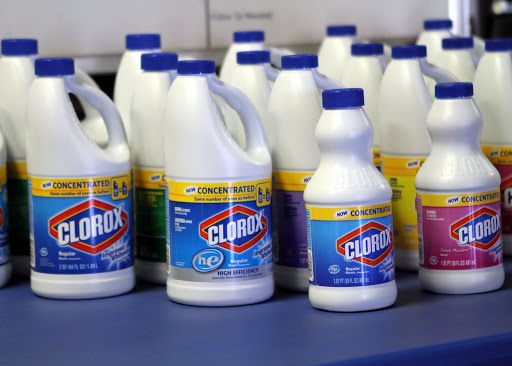
I learned this today. Bleaches react with colored organic compounds and turn them into colorless ones.
Bleaches by working on the chromophore of a molecule. This is the part of the molecule that is responsible for the color we see. Our eyes do not see color. Our eyes detect a wavelength of light, which they pass to our brains, and our brains associate that wavelength with a specific color. For example, red is a wavelength of between 620 and 750 nanometers, green is from 495 to 570 nm, and blue is from 450 to 495 nm. The wavelength we see is the wavelength that is reflected off the object we are looking at. For example, a red rose absorbs all wavelengths of light up to 620 nm and reflects all wavelengths above that. Our eyes detect the reflected wavelength and see it as “red”.
The chromophore is the part of the molecule that is responsible for its color. Chromophores are chains of atoms connected by alternating single and double bonds. These atoms that are bonded together have anti-bonding electrons that are orbiting at a certain distance from the atom. These electrons can jump to a higher orbital distance if they have more energy. If an electron is going to jump to the next orbital ring, it needs to have the right amount of energy and it gets this energy by absorbing light. Light with shorter wavelengths has more energy than light with a longer wavelength. The number of double bonds decides the amount of energy that the electrons will need to jump. If the energy required for the electron to jump is 450 nm, the electron will absorb that energy and reflect anything above it, appearing blue. If an object. The fewer double bonds the molecule has, the less energy it can absorb and the closer it becomes to white.
Bleach works by either breaking the bonds between these atoms or changing double bonds to single bonds.
Clothes can be bleached naturally by leaving them in the sun. Photons of light disrupt the bonds of the chromophore. It takes a long time, but if you leave a picture in the sun for long enough, it will fade to almost white.
Chemical bleaches break the bonds in two ways. The first is by oxidizing. Peroxide-based bleaches have oxygen as their active agent. When clothes are washed in this kind of bleach, the oxygen molecules get into the atom chains and they break up the bonds between them. This stops them absorbing energy and they either reflect all the light back, which makes them white, or they absorb some of the light and reflect a color outside of the visible spectrum, which we also see as white. This is the same process by which hair is bleached as well.
There is also a type of bleach called a reducing bleach. This has the same result as an oxidizing bleach, but it does it by reducing the double bonds in the chromophore down into single bonds. This also stops the chromophore from absorbing any energy.
The idea of bleaching fabrics has been around for thousands of years. The first fabrics were bleached in 5000 BC by the Egyptians using sunlight and water. This is a long process and can only really fade fabrics.
In 3000 BC, people made bleaches by mixing wood ash and water, which gave them a lye solution. Lye is a metal hydroxide and works by oxidizing the chromophore. The clothes would be soaked in the lye and then left in the sun. This would work, but it could take months and the clothes were likely to disintegrate.
In 1000 AD, the Dutch realized that adding sour milk to the process would counteract the damaging effects of the lye and the clothes would last longer. It still took many weeks to bleach fabric, though. In 1756, Francis Home discovered that replacing the sour milk with a weak sulfuric acid reduced the time it took to bleach the clothes down to 12 hours.
Then, in 1774, Carl Wilhelm Scheele discovered chlorine and everything in the world of bleaching changed. However, it was another scientist, Claude Berthollet, who realized that chlorine could be used to bleach fabric. By 1799, a bleaching powder had been patented and was on the market. An interesting side effect of the research into bleach was that in 1820, Antoine Labarraque discovered that was also an effective disinfectant, which brought a huge change in the world of hospitals and medicine. The bleach we used came to the market in about 1930.
So, bleach works by destroying or reducing the double bonds between atoms in the chains that are called chromophores, reducing the amount of energy they are capable of absorbing. And this is what I learned today.
If you read this far, I would appreciate a like and a follow.
Photo By Adina Firestone – IMG_7066 (1), CC BY-SA 2.0, https://commons.wikimedia.org/w/index.php?curid=38047217
Sources:
https://en.wikipedia.org/wiki/Bleach
https://en.wikipedia.org/wiki/Chromophore
http://scienceline.ucsb.edu/getkey.php?key=551
https://www.thoughtco.com/understand-the-visible-spectrum-608329
https://www.britannica.com/science/atom/Orbits-and-energy-levels
https://wonderopolis.org/wonder/how-does-bleach-work
https://whatisbleach.weebly.com/history.html
https://www.britannica.com/biography/Carl-Wilhelm-Scheele
https://en.wikipedia.org/wiki/Lye
